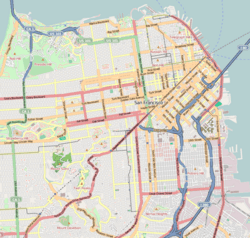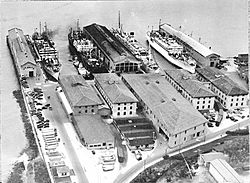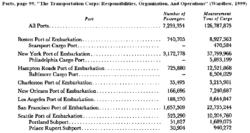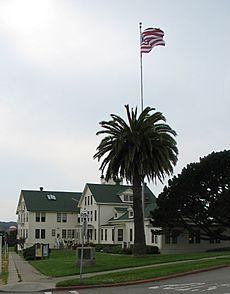Fort Mason facts for kids
|
San Francisco Port of Embarkation, US Army
|
|
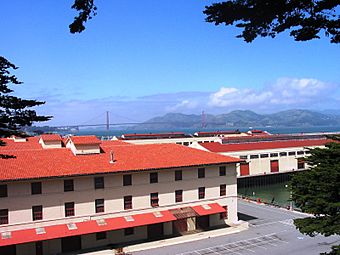
Historic wharves at Lower Fort Mason, viewed from Upper Fort Mason
|
|
| Location | San Francisco, California |
|---|---|
| Area | 21 acres (8.5 ha) (landmarked area) |
| Built | 1912 |
| NRHP reference No. | 85002433 |
Quick facts for kids Significant dates |
|
| Added to NRHP | February 4, 1985 |
| Designated NHLD | February 4, 1985 |
Fort Mason is a historic former United States Army base in San Francisco, California. It sits right on the edge of San Francisco Bay in the northern Marina District.
For over 100 years, Fort Mason was an important Army site. It started as a place to defend the coast. Later, it became a major military port. During World War II, it was the main port for sending troops and supplies across the Pacific Ocean.
The land for Fort Mason was first used for defense during the American Civil War. It was named in 1882 after Richard Barnes Mason, an early military governor. From 1904 to 1907, Fort Mason was the main office for the Army in California and the Hawaiian Islands.
In 1912, the Army began building a port here. They added piers and warehouses. This port became a home base for Army ships. These ships traveled to Alaska, Hawaii, the Philippines, and other Army posts in the Pacific. It was key for supplying the Army in the Pacific region.
Contents
Fort Mason's Role in World War II
On May 6, 1932, the port at Fort Mason was officially named the San Francisco Port of Embarkation. This was like the New York Port of Embarkation, which sent U.S. Army forces during World War I. The San Francisco port was set up to serve the Pacific.
Fort Mason became the main office for this new command. It also managed the Army Transport Service and other supply operations. When war started in Europe in 1939, the New York port became very busy again. But in the Pacific, only the San Francisco port was fully ready.
The Army soon realized that Fort Mason's port was too small for a big war. So, in early 1941, they started getting more land and buildings. They expanded in Oakland, Seattle, and other parts of San Francisco. By the end of World War II, the San Francisco Port of Embarkation included Fort Mason and thirteen other facilities.
The San Francisco Port of Embarkation was the second largest of eight such ports during World War II. It closed on October 1, 1955. After that, it became the main office for the Pacific Transportation Terminal Command.
Today, Fort Mason is part of the Golden Gate National Recreation Area. It is also home to many cultural places. The entire fort area is a historic district. It has 49 important historic buildings spread over 1,200 acres. The lower port area is a National Historic Landmark District. It earned this title because of its huge role in World War II.
Exploring Fort Mason's Landscape
Fort Mason has two main parts. The upper area is on a high piece of land. This is where the first coastal defenses were built. It is sometimes just called Fort Mason.
The lower area is called Fort Mason Center. It is closer to the water, west of the upper part. This is where the old military port, with its piers and warehouses, was located. The Marina Green is to the west of Fort Mason. Aquatic Park is to the east.
A Brief History of the Land
The land that became Fort Mason was once owned by John C. Frémont. He was a famous explorer of the western U.S. He also helped California become part of the U.S. and ran for president in 1856.
During the American Civil War, the government took Frémont's land. They said they needed it for the war effort. This happened in 1863. For many years, Frémont and his family tried to get paid for the land. This legal struggle lasted for over a century.
Fort Mason Today: Arts, Culture, and Parks
Today, Fort Mason is a lively place. Some of the old Army homes are still used by the military. Others are rented out to the public. One large building is now a youth hostel, run by Hostelling International USA.
The entire former base is now a mix of parks and gardens. Many old buildings from the late 1800s and early 1900s are still in use. A path runs along the harbor, offering great views. You can see Alcatraz and the Golden Gate Bridge.

The lower part of the site is known as the Fort Mason Center for Arts & Culture (FMCAC). This is a non-profit organization. Its campus has many arts and culture groups. These include the San Francisco Museum of Modern Art Artists Gallery, San Francisco Art Institute graduate campus, and the Blue Bear School of Music. You can also find Greens Restaurant, Readers Bookstore, and the Magic Theatre here.
The National Park Service has its main offices for the Golden Gate National Recreation Area and the San Francisco Maritime National Historical Park at Fort Mason. The United States Park Police also have operations here. They provide police services for the Golden Gate National Recreation Area.
Since 2010, from March to October, a popular event called Off the Grid happens every Friday. Many food trucks gather, drawing large crowds.
Future Plans for Fort Mason
There is a plan to extend the historic streetcar lines, like the F Market & Wharves or E Embarcadero, to Fort Mason. This extension would run from near Fisherman's Wharf. It would go past the San Francisco Maritime Museum and Aquatic Park. Then, it would travel through an old, unused San Francisco Belt Railroad tunnel under Upper Fort Mason.
Studies have been done to see if this extension is possible. The goal is to make it easier for people to visit Fort Mason and enjoy its history and cultural activities.
Images for kids
-
The San Francisco Art Institute at Fort Mason in 2017


